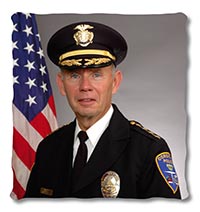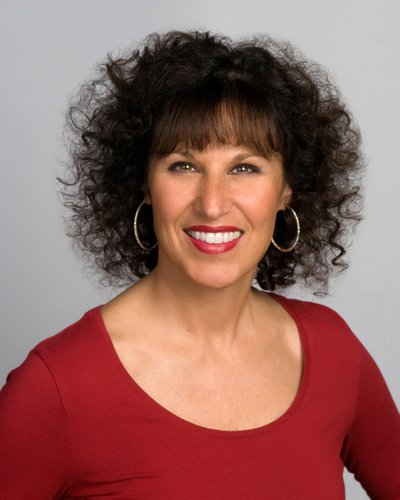Interviewing Coronado Police Chief Lou Scanlon is much like the character of Emperor Joseph II critiquing Mozart’s music in the movie “Amadeus,” when he said, “Too many notes.” Although my notes are typewritten and decidedly not musical, writing a novella starring Coronado’s Top Cop, who announced his retirement last week, would not be out of the question.
The Lawrence, Massachusetts native of Irish descent worked in high school and college as a lifeguard. Remembering those days, Scanlon laughed and said, “I guess I have been in one uniform or another since I was 16.” After graduating with a Bachelor of Arts in Psychology from Boston College in June of 1967, in September of the same year Scanlon found himself in Naval Flight School in Pensacola, Florida.
Technically Scanlon was a ‘Vietnam Era’ pilot who flew F-4 fighter jets. “I was on the USS Saratoga during the war between Jordan and Syria, when Russia was flying aircraft into Egypt. We intercepted them and flew side-by-side to let them know we were there. With the Vietnam War ending, I became a reservist in 1972. I was discharged from the Navy in San Diego and stayed. It’s a funny story. It was around Thanksgiving when I got out and I had been in warm places for the past five or six years. I called home and my mom said, “You’re going to love it when you get back home for the first snowfall.” I decided to stay in San Diego. I go back to visit, but I stayed in San Diego.”
A family background in law enforcement led to a similar career path for Scanlon, as he explained. “My parents were Irish immigrants and they owned and managed restaurants. Where I grew up, they had an odd system where aldermen ran citywide for a specific job and my Dad (also named Louis J. Scanlon) ran as an alderman for the Department of Public Safety and had the police and fire departments under him. He was in the state legislature in the 1930s and served with Henry Cabot Lodge who became a good friend of Dad’s, James Michael Hurley, (eventual Governor) Leverett Saltonstall and John Francis (Honey Fitz) Fitzgerald.” Thus Scanlon Sr. served in the legislature with the maternal grandfather of John F. Kennedy. “Dad was born in 1899 and was too young for World War I,” Scanlon said. “He enlisted in WW II. He didn’t run for a second term and enlisted in the Army instead.”
So back to Lou Jr. “I got out of the Navy and got an apartment with a couple of guys going through the San Diego Police Academy. They said it was a lot of fun and interesting, plus I grew up in that environment. So I went to the Academy in 1974.” And Scanlon stayed for 33 years. “I did everything from being a pilot in air support to being a SWAT (special weapons and tactics) sergeant. Eventually I rotated through all four assistant chief positions. When I left, I was the assistant chief of patrol, which included everyone in uniform except traffic officers, and totaled about 1,600 people.”
Through much of his law enforcement career, Scanlon remained in the Navy Reserves, retiring in 1996. A unique way to follow his career path is through his Navy pilot call signs which started with ‘Shamrock,’ a nod to his Irish lineage; progressing to the police-inspired slang term ‘Heat’ and eventually to ‘Chief.’
Memorable cases while with the San Diego PD included serving as a SWAT officer during the Brenda Spencer shootings in 1979 at Cleveland Elementary School, where she killed two people and injured nine. He also served during the PSA Flight 182 crash in 1978 and responded to the San Ysidro McDonald’s Massacre in 1984.
In 2007 at the age of 62, Scanlon retired due to a complex retirement policy in the city of San Diego, which coincided with an opening in the Chief’s position in Coronado. “I was familiar with Coronado because I had lived here for a short period when I was in escrow between houses. Also one of the reserve units I drilled with was assigned to the USS Kitty Hawk and the USS Ranger. I would come here on weekends to drill and I lived at the Shores for a couple of months. I had been contacted by search firms for jobs outside the area, but I didn’t want to leave San Diego. My wife’s family is here and I didn’t want to go back to places where it snows. This (Coronado) is a very attractive city to work in, obviously.”
The Coronado Police Department is budgeted to have 44 sworn officers and 67 total employees. Scanlon discussed staffing challenges in the department. “The toughest hire in the city is to find good officers. There is no other job in the city where people have to be psychologically tested. By law, they are the only applicants in California you can polygraph. It’s even tougher hiring dispatchers.”
Scanlon discussed some of the events that occurred in Coronado during his tenure. “We had a number of big cases, including the incident at the Shacknai residence and last New Year’s Eve with the Navy pilots. We also had the Red Bull races, the Centennial of Navy Aviation and the basketball game with the President here.”
According to Scanlon, departmental advances over the past five years came in a variety of areas. “We got Silver Strand State Beach to ban alcohol. That used to be a problem area for us, especially with drinking on the Fourth of July. Also the Psychiatric Emergency Response Team (PERT) was instituted here, where clinicians who ride with the officers deal with people with mental illness or who are undergoing psychotic episodes. The only thing officers can do is enforce the law. They can’t arrest people unless they are a danger to themselves or to others. They can only take someone to the county mental facility and commit them for 72 hours. PERT clinicians speak the language and have connections with other private facilities which can provide the best care for people. They deal pretty effectively with people and they have connections with local facilities. They get people the care they need, prevent things from escalating and save lives.”
Scanlon continued, saying there were two things people thought could never get done. The first was banning big ‘for sale’ signs on vehicles on Orange Avenue, particularly between Third and Fourth Streets. The second was a towing contract. “There was no towing contract when I got here and there was no way to hold anyone accountable. A new contract will be let soon. The complaints regarding tows have diminished to just a handful.”
“Another thing the community doesn’t realize is Coronado has the lowest crime rate of all 18 cities in the county,” said Scanlon. “Since 2007, which is when I got here, property crime is down 13 percent. The FBI Index which measures all crimes has gone down 10 percent without an increase in staffing levels. With property crime, most of it is preventable by the owner. Stolen bicycles are the most common property crime. In a lot of cities, it’s stolen cars.”
Scanlon and his wife Pam plan to travel. She serves as the executive director of the Automated Regional Justice Information System, (ARJIS) which is a consortium of 71 law enforcement agencies from San Diego and Imperial Counties, at the local, state, and federal levels. So travel plans will now have to be worked around Pam’s schedule.
It’s fitting to give Scanlon the last words for this article. “It’s been wonderful working with the great citizens of Coronado. They are incredibly supportive of their police department.”







